Bassdozer Weedless Spoon Jig ~ For Fresh or Saltwater Fishing
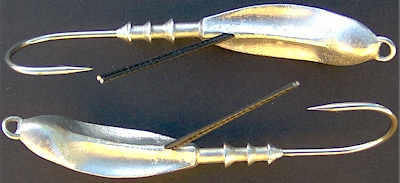
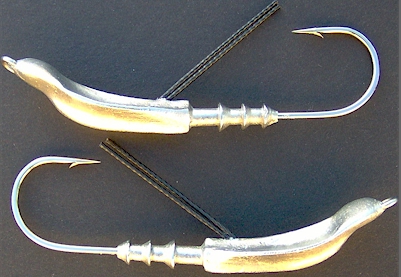
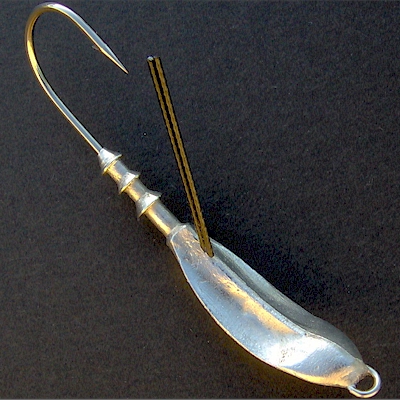
Bassdozer Spoon Jig ~ 1/2 oz Tin (Unpainted)
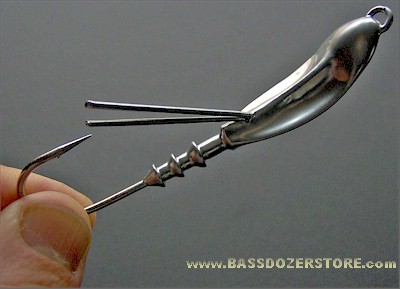
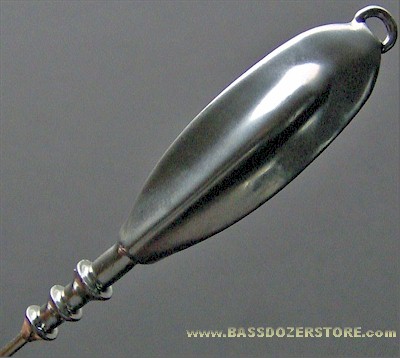
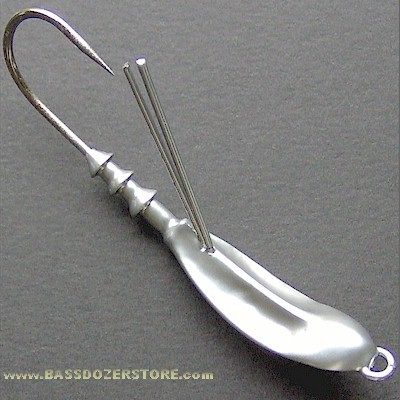
Bassdozer Spoon Jig ~ 3/4 oz Chrome (Painted)
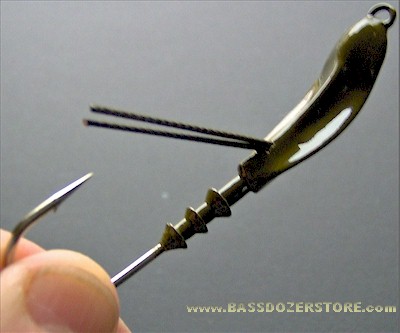
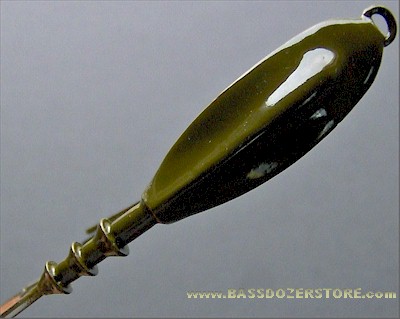
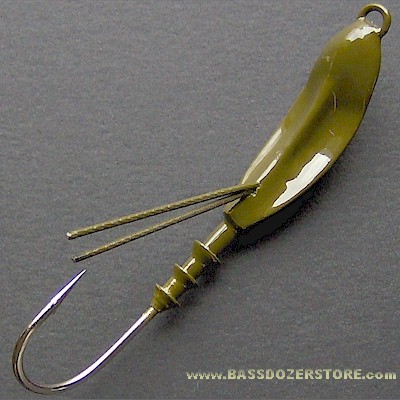
Bassdozer Spoon Jig ~ 3/4 oz Green Pumpkin
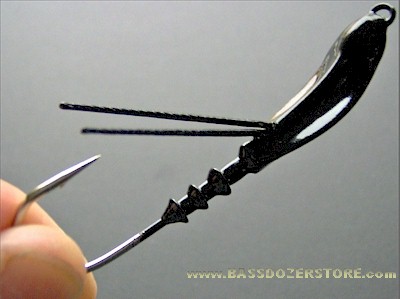
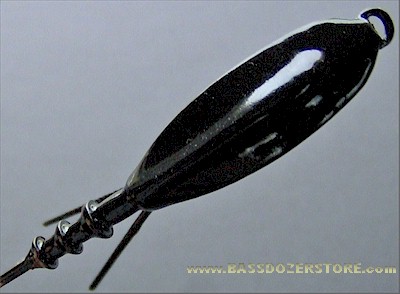
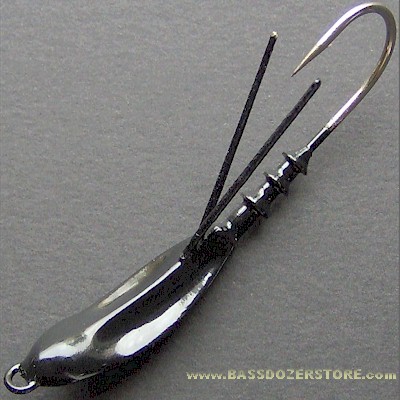
Bassdozer Spoon Jig ~ 3/4 oz Black
From the photos, construction and its name, some people may mistakenly of the Spoon Jig as a spoon - but it is not a spoon.
The Spoon Jig is more of a jig head that works best with long (5" and up) relatively straight tailed soft baits and gives them anywhere from a fast tail-whipping action to a slow and snakey S-action depending on the bait.
Think of the Spoon Jig as a wobble plate that makes soft baits wiggle and roll with the sinuous S-shaped swimming action of live baitfish, worms and eels.
Also, many anglers have been using my Spoon Jigs with solid-bodied and hollow-center swimbaits/ It does not add action to swimbaits on the retrieve, but it does make swimbaits weedless - and it makes swimbaits wobble as they fall.
- The Spoon Jig has an aerodynamic streamlined shape that makes for extra long distance casts, even against a stiff breeze.
- Has a heavy duty 5/0 Mustad UltraPoint hook, and two-prong adjustable black nylon-coated wire guard.
Spoon Jigs come in two weights, both the same shape, size and everything the same except the weight:
- 1/2 oz Tin Model. Unpainted.
- 3/4 oz Lead Model. Painted various colors.
Both the 1/2 and 3/4 oz sizes produce identical swimming actions.
Both have the same heavy duty, long shank 5/0 Mustad UltraPoint spinnerbait hook and a two-prong wire weedguard.

Features include:
- A Lip for Soft Baits. Think of the Spoon Jig as a diving lip that makes a soft bait wiggle and roll like a lipped crankbait or plastic-lipped jerkbait. It's like a crankbait bill for soft baits, except snagless!
- Aerodynamic. Streamlined shape makes for extra long distance casts, even against a stiff breeze.
- Wire Brush Guard. Can be fine-tuned for the optimum hookset under any and all conditions. Has equivalent snag-resistance as standard fiber brush guard - except the wires can be precisely adjusted for the conditions at hand. In open water, bend brushguard down and out to the sides below the hook so the point is exposed.
- Heavy Duty Stainless Steel Line Tie Eye. You may carefully bend the line tie eye up ro down in order to fine-tune the swimming action of whatever soft bait you're using. There's almost always a "sweet spot" where the angle of the line tie eye (bent up or bent down) will result in the most lifelike action.
- Triple Cone Cut Keeper Collar. Each cone has 360 degrees of bait-gripping power, or 1,080 degrees of bait-grip in all. The amply spaced and ringed cones like those shown are the best of all ways to hold soft plastic baits securely. Even holds better than glue!
Flip It. Can be flipped or pitched into tight cover like any weedless jig except it wiggles enticingly on the way down as it is falling. Let it hit bottom, hop it a bit, then swim it out, wiggling its tail all the way.
Cast and Retrieve It. Can be fished shallow or deep, and attracts suspended bass in mid-depths. Comes through cover surprisingly swell! Equally at home in shallow cover or off deep points and ledges - or anywhere.
About the Wire Weed Guard. It can be fine-tuned for the optimum hookset under any and all conditions. The wire can be adjusted up or down and squeezed in or spread out. Can be fine-tuned for clean open water or for light, medium or heavy weed and snag defense.
- In clean, open water with little or no weeds or bottom obstacles to snag on, bend both wires down and in to the sides so the wires sit below the hook point.
- In weedier or snaggier conditions, adjust the wires up and fanned out more to the sides for more snag defense.
Keep in mind, the two-prong wires are often more helpful used as side deflectors (vee'd out to the sides) rather than straight up directly in front of the point.
In tough areas, it will surprise you how snag-resistant this jig head can be, wiggling its way through the snags.
Best of all, the wires really don't hamper the fish's strike. The wires do not interfere with your hookset.
How to Attach to Your Line. In thick or grassy cover, you may desire to tie directly to the heavy duty stainless steel line tie eye. The reason to tie direct is it's the most weedless way to avoid getting weeds or debris piled on the front. Or you may use a stout split ring and tie to the ring. Or use a reliable snap. It doesn't make much difference in terms of action or fish-catching ability. They're all good ways to tie your line to the Spoon Jig.
Fine-tuning the Swimming Action. You may carefully bend the line tie eye up or down in order to fine-tune the swimming action of whatever soft bait you're using. There's almost always a "sweet spot" where the angle of the line tie eye (bent up or bent down) will result in the most lifelike action with a particular bait.
Use Big Worms, Flukes, Slug-Gos, Senkos, etc. The Spoon Jig is ideal for any beefy worms or long-bodied soft baits over five inches long. You've seen Senkos shimmy and wiggle before, just never with an eel-like S-shaped swimming motion like this! Slug-Gos develop a fast-whipping tail motion like a frantic baitfish that bass can't resist. Many other long-bodied baits have enhanced swimming actions, which can be adjusted. with the Spoon Jig. You see, the line tie eye is stainless steel and also adjustable. So you can fine-tune the swimming action of any bait used on a Spoon Jig.
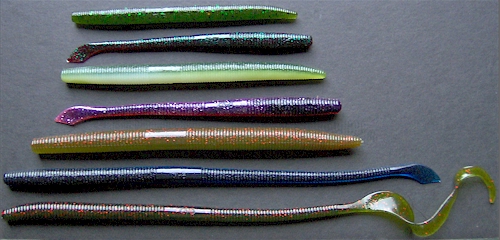
Top down: 5" Yamamoto Senko, 5-3/4" Kut Tail, 6" Senko, 6-1/2" Kut Tail, 7" Senko, 10" Kut Tail, 12" Curly Tail

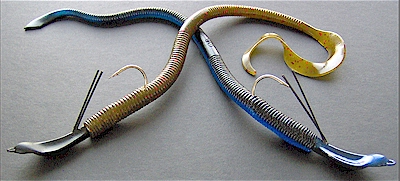
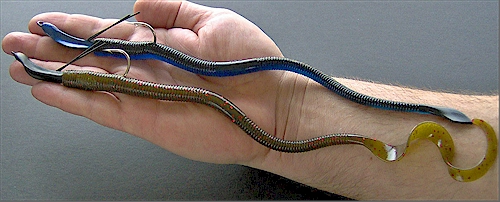
Yamamoto's new 10" Kut Tail and 12" Kurly Tail (or most any brand or model of big worm) will swim with lifelike action on the spoon jig heads. It's very easy, just reel steadily, and the spoon jig creates all the irresistible swimming movement, plus it's snagless. What could be easier?

Spoon Jig makes any swimbait weedless in the heaviest cover and swimbaits will swagger and sway like wounded baitfish when you let them fall.
Many anglers also favor the spoon jigs for big hollow belly swimbaits, even though the protruding spoon looks a little odd in front of a swimbait body. However, if bass really cared about that, then you'd never catch another bass on a long-billed deep-diving crank, so don't worry about the spoon jig's bill either. What swimbait anglers love most is that the spoon jig gives a swimbait a flipping, flopping, swerving, side-to-side fall when it sinks and of course. it's snagless. So you can swim a swimbait in the heart of thick cover, right in the lunkers' dens. Then let it drop strategically right in fornt of a lunker's hidout. The spoon jig will make a swimbait flip, flop and swerve to the bottom like an injured big baitfish that's out of control. Well. it's more than any lunker can resist!
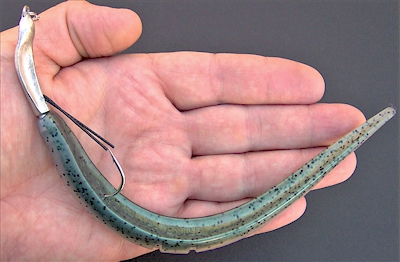
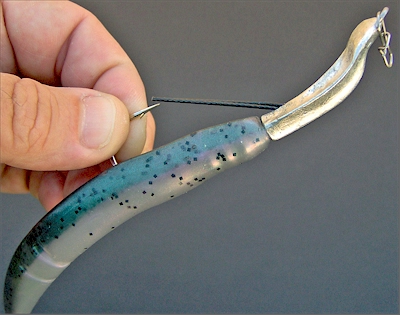

Rigged with 7-1/2" Lunker City Slug-Go. Is this the best soft plastic jig and tail combo for Northeast Atlantic striped bass fishing? Anglers in the know say so.
Both the 7-1/2" Slug-Go (shown) and the 6" Slug-Go are perfect dressings for the Spoon Jig.
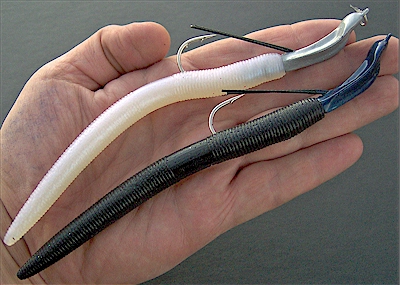
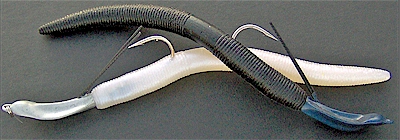

Rigged with 6" Yamamoto Senko (9L series)
Different soft bait models may exhibit their own unique swimming styles as they practically spring to life on the Spoon Jig. For instance:
- A 6" Yamamoto Senko Lite exhibits a more snake-like "S" action like an eel
- A 6" Lunker City Slug-Go produces a more frantic tail-whipping action like a sand eel or baitfish
- A 5" Zoom Super Fluke wobbles side-to-side more like a hard plastic jerkbait or plastic-lipped minnow
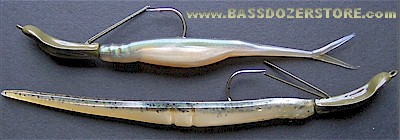
5" Zoom Super Fluke and 6" Lunker Ctiy Slug-Go have incredible swimming actions on Spoon Jigs.
Those are just a few of the many soft baits you can use with the Spoon Jig.
Use a 6" to 12" length of surgical tubing instead of soft baits for toothy critters like bluefish or barracuda in saltwater and pike or musky in freshwater.
For the very deadliest of all striped bass lures in saltwater (or fresh), use dead rigged eels up to 12 inches long (please check your local fishing regulations first) lashed securely to the jig collar with rod-wrapping thread. These pay be preserved in heavy brine solution (or salted and frozen) between fishing trips.
Use Tough Plastics. The ideal plastics to use with the Spoon Jig are those with harder, tougher plastic formulations. Tougher plastic baits last longer when used with the Spoon Jig. Super soft baits get as many strikes, but do not hold up as long. Softer baits tear more quickly where the hook exits the body and need to be replaced more often when used with the Spoon Jig.

For pricing and current availability, please visit http://www.BassdozerStore.com.
Thank you for your business. May your next fishing trip be your best ever!
Regards,
Russ
